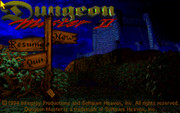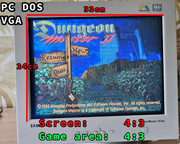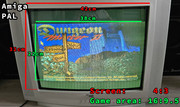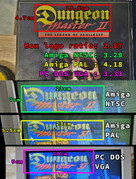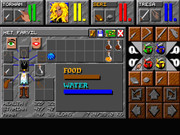This week I started uploading gameplay footage from Dungeon Master 2 for Amiga. For convenience, I don't grab the actual hardware, but rely on the emulators: DOSBox for DOS and WinUAE for Amiga. I also pay attention to not misrepresent the original graphics of the game: I take care to maintain the correct aspect ratio to avoid distortions and I crop any "black belts" at the edges of the screen. I came to trust the emulators over the years as I grabbed footage from many games with them, but now I think I did not fully understand what they are doing with the intended graphics display of the games.
But, back to the videos: to double-check if my recording is not distorted I sometimes look for shapes that I know should be a perfect circle or a perfect square and confirm that they are indeed so. In case of Dungeon Master 2, I relied on the inventory screen slots and attack icons to be perfect squares. I also check if the in-game mouse cursor moves with equal sensitivity in both the vertical and horizontal directions.
Things seemed good, the squares checked out, but this time, I might've been off.
Here's the screencap of the game's main menu, taken straight from my video:
2 videos recorded and uploaded, and I get a message from my pixel-perfectionist friend informing me that the picture in my videos is le bad:
- the castle in the background is squashed,
- the game logo is stretched wide,
- and the options pole is too thick.
First of all, I think that the main menu is the best to use here for comparisons because it covers the whole "rendering area" of the game, whereas the gameplay screen leaves some black space at the bottom for the "Torham has gained a Ninja level" texts.
About the Resolution of My Recordings
The screenshot from my video is 1728x1080 pixels. The game doesn't run in this resolution, of course, but I do some upscaling both with WinUAE and with the recording software to make sure the resolution is "pulled-up" to FullHD height-wise, but I don't muck with the aspect ratio. I also prefer to upscale without filtering as much as possible to maintain the square crispness of the pixels (no bilinear filtering). The original resolution in WinUAE, before all the upscaling, is 640x400. This gives an aspect ratio of 16:10. I upscale this by 2 to 1280x800 in WinUAE without filtering, then upscale it to 1728x1080 with the recording software, this time with filtering (the pixels get slightly blurry, but not distorted). 1728x1080 is the same aspect ratio of 16:10 as 640x400, so everything should be okay, right? Right?! Well, no...
The problem is that the ratio most likely shouldn't be 16:10 in the first place.
To the Point
I own some ye olde hardware and did some comparisons. I'm purposefuly sharing photographs taken by phone, not screenshots, because I want to be sure that everyone is seeing what I am seeing. Also, the exact measurements and units are not that important, only the proportions are. Pardon my sloppy photography too.
Photographs of CRT Displays
This comes from a Pentium 133 MHz PC running FreeDOS:
Already, the ratio is completely different. It's 4:3 now, not 16:10. Also, you can see that the game's graphics fill the whole screen. So, is this correct? Is this "not distorted"?? Is this what I should be aiming for???
Let's see with a real Amiga 1200 with a PAL CRT Television screen:
We're back to square one! On the screencap I've written a strange ratio of 16:9.5 because 16:9 and 16:10 are close to each other and my measurements were probably too inaccurate (or the TV just displays that way). With this ratio we're back to how I see things in WinUAE, and far away from the PC's 4:3. Is the game's ratio supposed to be different on Amiga than what it is on PC?
Then I remembered something. FTL were based in US, right? And I live in Poland, Europe. Different TV standards: NTSC in US and PAL where I live. NTSC is "slightly" shorter height-wise than PAL. Fortunately, Amiga can be switched to NTSC at boot, and for some reason (that I can't explain due to the lack of technical knowledge), my TV can take that.
So, let's check Amiga 1200 booted into NTSC mode with a CRT Television:
Great success! The screen is filled whole, and the ratio is 4:3, the same as PC. I played around in the game proper a bit in this mode and there are no new distortions. Is this the right way to play, then?
Game's Box
Well, we can take a look at one more thing. The game's logo, which is also on game's box. One disclaimer though: this is a box for Polish distribution of the game for the PC. Not sure how consistent it is with other distributions of the game.
Uh, okay, this is all over the place. I measured the logo from the leftmost of the 'D' straight right to the end of the 'n' letter, and from the topmost of the 'D' straight down to the bottom of the 'm' (in master). NTSC and VGA measurements look consistent, but boxart is off (or rather: simply different).
But, the box has a backside where screenshots from the game are shown:
At a glance, the screenshots don't look horribly distorted. The inventory icons (hands) are square.
So, let's have some measurements of the screenshot on the back of the box:
One thing to note here is that the screenshots on the box don't include the "Torham has gained Ninja level" black area, but this area is about as tall as the movement control arrow, so I doctored the picture a bit and added the height of the arrow (0.4cm) to the whole height of the screen (3cm). The ratio on the box is close to 16:10 again. So, if the ratio on the PC is 4:3, the screens on the box for the PC don't match. It might just be that the screens on the box are not a good reference for the developer's intention, so let's move on.
Emulators
I confirmed that the game renders in 4:3 in DOSBox, provided you configure it with aspect=true. Look:
Okay, so let's try NTSC mode in WinUAE emulation. Emulated Amiga can be booted into NTSC mode in the same way that the real Amiga can. Here are two photos with PAL and NTSC modes:
The NTSC resolution is 640x475 for some reason, but that's close enough to 4:3. Is the problem solved, then? We can now just upscale this by 2 to maintain pixel crispness, which will give us a resolution of 1280x950, and we're good to go, right? Right?! Well, there's a price to pay. Here comes a WinUAE NTSC screenshot with some text:
On this pic you can see pixels duplicated vertically on some of the horizontal lines. Compare the "ROBLP" savegame names and notice that none of the 3 look the same.
Conclusions
Keep in mind that my goal is to have correct results in the emulator, not the real hardware. If I wish to maintain both crisp pixels and 4:3 ratio, the horizontal line distortions ("ROBLP") will be visible throughout the game in many different areas. It's possible to get rid of these distortions by enabling bilinear filtering in WinUAE's "Filter" section, but then the whole image becomes blurry, which to me looks awful.
So, I can choose from only 2 of the 3:
- the "intended" 4:3 aspect ratio,
- pixel crispness,
- no horizontal-line distortions.
When it comes to the CRT and why it does it well: CRT can just stretch 16:10 graphics to 4:3 vertically without distortions because, well, it's a CRT. All the pixels on screen simply get slightly elongated height-wise, which is not that noticeable to the naked eye, and thus the picture still looks OK, even if the actual rendering surface of the game is 16:10. LCD displays can't do that, and the rendering surfaces of emulators most definitely can't do that either without extra filtering.
Unless there is a better method to do this, at this point I'd rather prefer to stay at the supposedly wrong 16:10 ratio and don't have any blurry or distorted pixels.
Extra info tidbit on DOS games rendered in 16:10 and stretched to 4:3
My knowledge is spotty here, so there will be omissions. From what I know, the process of rendering a DOS game to an in-memory surface of resolution 320x200 (which is ratio 16:10) was not uncommon back in the day. One of the reasons this was done was because such 320x200 surface fit into a 64KB of RAM. Check this out: https://doomwiki.org/wiki/Aspect_ratio
The game, rendered to 320x200 (16:10), was then elongated vertically to a 4:3 ratio when displayed (think scaling up from 320x200 to 320x240). What I don't know here is how exactly was this done? Which piece of hardware was responsible for doing this, and why specifically there are no visual artifact? Also, why not just display the view letterboxed? Perhaps it was considered that it's better to fill the whole screen because the user has paid for the whole screen.
There's some discussion about this on Doomworld forums, but I didn't sift through all the posts, yet:
https://www.doomworld.com/forum/topic/9 ... stretched/
How does Amiga's Lisa digital graphics chip see it?
Okay, one last photo. My Amiga 1200 is equipped with an Indivision AGA MK2 card which is inserted over the computer's Lisa graphics chip (which is connected in the circuitry before the Scart-RGB DAC). Indivision allows to connect the computer to a modern screen directly via a DVI cable (or DVI-to-HDMI).
This is what I see on an LCD screen when I boot the Amiga in NTSC mode and run the game:
Yeah, it's 16:10. And also if I boot the computer in the PAL mode, I see the same thing. 16:10 throughout.
P.S.
I've been running around my flat with measuring tapes all Saturday since 10:00 AM and now, in the evening, as I conclude this post and press Submit, my Saturday is officially ruined.

